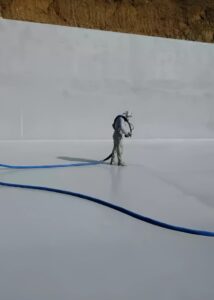Waterproofing Guide for Beginners | Basics of Waterproofing 2024
Basics of Waterproofing is the process of protecting buildings and structures from water damage. It involves applying materials or systems that prevent water from entering through walls, floors, or roofs. Waterproofing keeps water out of your home or building by using special coatings, membranes, or barriers.
Why is it Important Basics of Waterproofing:
It prevents leaks, mold, and damage to your structure, saving you money on repairs and improving the longevity of your property.
- Prevents Water Damage: Waterproofing protects your property from water damage, which can lead to structural issues like cracks, peeling paint, and deteriorating foundations.
- Improves Comfort: Waterproofing helps maintain a dry and comfortable living environment by preventing dampness and humidity inside the building.
- Enhances Durability: Proper waterproofing extends the lifespan of buildings and structures by protecting them from the corrosive effects of water.
- Increases Property Value: A well-waterproofed property is more attractive to potential buyers and can enhance its market value.
- Reduces Mold and Mildew: By keeping moisture out, waterproofing helps prevent the growth of mold and mildew, which can impact indoor air quality and lead to health problems.
- Saves on Repairs: By addressing potential water issues before they become serious problems, waterproofing can save on costly repairs and maintenance in the long run.
Eco-Friendly Waterproofing Solutions refer to sustainable methods and materials used to prevent water penetration in structures while minimizing environmental impact. These solutions often utilize non-toxic, biodegradable, and energy-efficient products that reduce carbon footprints.
- Plant-Based Sealants: Made from natural oils and resins, these sealants are biodegradable and safe for the environment.
- Green Roof Systems: These systems incorporate vegetation that not only provides waterproofing but also improves insulation and reduces urban heat islands.
- Recycled Materials: Some waterproofing membranes and barriers are made from recycled materials, reducing waste and conserving resources.
- Water-Based Coatings: These coatings contain fewer volatile organic compounds (VOCs) and are less harmful to both indoor air quality and the environment.By choosing eco-friendly waterproofing solutions, you can protect your property while supporting sustainability and reducing the environmental impact of construction practices.
Types of Waterproofing:
- Liquid Membranes: Applied as a liquid and dries to form a protective layer.
- Bituminous Membranes: Waterproof layers made from bitumen (tar-like substance).
- Sheet Membranes: Pre-made sheets that are rolled out and adhered to surfaces.
- Cementitious Waterproofing: Cement-based coatings that protect against water.
Common Areas to Waterproof:
- Basements: To prevent water from seeping in from the ground.
- Foundations: To avoid water damage to the building’s base.
- Roofs: To protect against rain and snow.
How to Choose a Waterproofing System: Consider the area you need to protect, the type of building, and your budget. Each system has its own strengths and is suitable for different conditions.
By understanding these basics, you can better protect your property from water damage and maintain its value over time.
Waterproofing is the process of making a structure or surface resistant to water penetration. It involves applying specific materials or systems designed to prevent water from seeping through walls, floors, roofs, or other parts of a building.
These materials can include coatings, membranes, and barriers that create a protective layer against water.





You’ve been great to me. Thank you!
Good web site! I truly love how it is easy on my eyes and the data are well written. I am wondering how I could be notified whenever a new post has been made. I’ve subscribed to your RSS which must do the trick! Have a nice day!
Thank you for being of assistance to me. I really loved this article.
May I have information on the topic of your article?
whoah this blog is great i love reading your posts. Keep up the good work! You know, many people are looking around for this information, you can aid them greatly.
You can certainly see your enthusiasm in the work you write. The world hopes for more passionate writers like you who aren’t afraid to say how they believe. Always follow your heart.